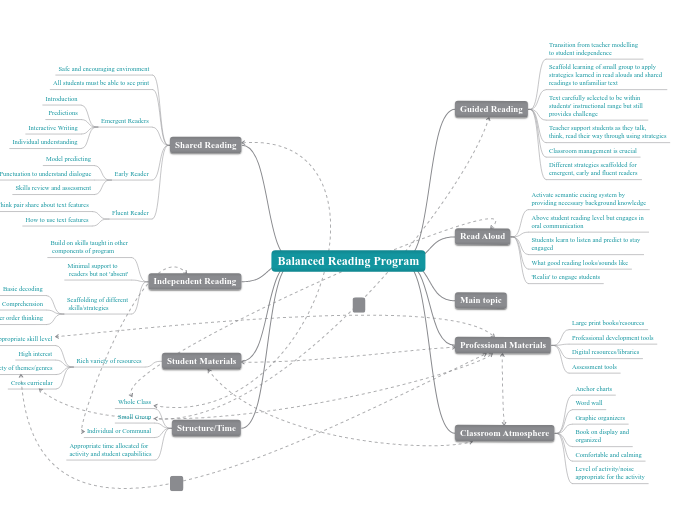Balanced Reading Program
Guided Reading
Transition from teacher modelling
to student independence
Scaffold learning of small group to apply
strategies learned in read alouds and shared
readings to unfamiliar text
Text carefully selected to be within
students' instructional range but still
provides challenge
Teacher support students as they talk,
think, read their way through using strategies
Classroom management is crucial
Different strategies scaffolded for
emergent, early and fluent readers
Read Aloud
Activate semantic cueing system by
providing necessary background knowledge
Above student reading level but engages in
oral communication
Students learn to listen and predict to stay
engaged
What good reading looks/sounds like
'Realia' to engage students
Main topic
Professional Materials
Large print books/resources
Professional development tools
Digital resources/libraries
Assessment tools
Classroom Atmosphere
Anchor charts
Word wall
Graphic organizers
Book on display and
organized
Comfortable and calming
Level of activity/noise
appropriate for the activity
Shared Reading
Safe and encouraging environment
All students must be able to see print
Emergent Readers
Introduction
Predictions
Interactive Writing
Individual understanding
Early Reader
Model predicting
Punctuation to understand dialogue
Skills review and assessment
Fluent Reader
Think pair share about text features
How to use text features
Independent Reading
Build on skills taught in other
components of program
Minimal support to
readers but not 'absent'
Scaffolding of different
skills/strategies
Basic decoding
Comprehension
Higher order thinking
Student Materials
Rich variety of resources
Appropriate skill level
High interest
Variety of themes/genres
Cross curricular
Structure/Time
Whole Class
Small Group
Individual or Communal
Appropriate time allocated for
activity and student capabilities
